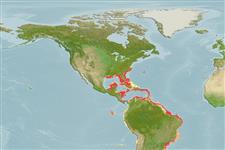Environment: milieu / climate zone / rango de profundidad / distribution range
Ecología
marino asociado a arrecife; rango de profundidad 3 - 320 m (Ref. 9710), usually ? - 60 m (Ref. 93218). Subtropical; 37°N - 30°S, 95°W - 34°W
Western Atlantic: Bermuda, North Carolina (USA) and northern Gulf of Mexico to Santa Catarina, Brazil (Ref. 57756). Most common lizard fish in the West Indies (Ref. 13442).
Tamaño / Peso / Age
Madurez: Lm ? range ? - ? cm
Max length : 46.0 cm TL macho / no sexado; (Ref. 26340); common length : 40.0 cm TL macho / no sexado; (Ref. 5217); peso máximo publicado: 1.0 kg (Ref. 5217)
Espinas dorsales (total) : 0; Radios blandos dorsales (total) : 11 - 12; Espinas anales: 0; Radios blandos anales: 11; Vértebra: 49 - 52. This species is distinguished by the following characters: D rays 11-12; A rays 11; total caudal rays 40-42; dorsal segmented caudal rays 9; ventral segmented caudal rays 9-10; dorsal procurrent caudal rays 11-12; ventral procurrent caudal rays 9-10; pelvic-fin rays 8; pectoral-fin rays 11-13; total vertebrae 49-52 (modally 50); pored lateral-line scales 49-52 (modally 51); median predorsal scales 16-17; scale rows on cheek 6-8; HL 15.2-28.4% SL (26.6%); orbit diameter 3.6-6.4% SL (4.7%) and 13.4-22.5% HL (17.2%); interorbital width 2.8-5.3% SL (4.3%) and 10.1-19.4% HL (15.9%); flap on anterior nostril is small and broad, its length 1.5-3.6% HL (2.4%); snout triangular in dorsal view; pelvic-fin length 23.1-26.7% SL (24.9%); when preserved, 3-6 dark bars on caudal fin spanning upper and lower lobes; with a small, rectangular-shaped, black scapular blotch (length 5.1-12.2% HL, mean 8.4%); there are 9-13 dark bars on trunk; colour in life, adults tan to olive and with unevenly distributed yellow stripes along body (Ref. 93218).
Body shape (shape guide): elongated; Cross section: circular.
Found on the sandy bottom around boulders or in sandy corridors in patch reefs (Ref. 5521). Uncommon near the shore.
Life cycle and mating behavior
Madurez | Reproducción | Puesta | Huevos | Fecundidad | Larva
Robins, C.R. and G.C. Ray, 1986. A field guide to Atlantic coast fishes of North America. Houghton Mifflin Company, Boston, U.S.A. 354 p. (Ref. 7251)
IUCN Red List Status (Ref. 130435: Version 2025-1)
Threat to humans
Harmless
Human uses
Pesquerías: escaso valor comercial; pesca deportiva: si; Acuario: Comercial
Herramientas
Special reports
Download XML
Fuentes de Internet
Estimates based on models
Preferred temperature (Referencia
123201): 17.2 - 27.1, mean 23.2 °C (based on 246 cells).
Phylogenetic diversity index (Referencia
82804): PD
50 = 0.5000 [Uniqueness, from 0.5 = low to 2.0 = high].
Bayesian length-weight: a=0.00457 (0.00221 - 0.00945), b=3.16 (2.99 - 3.33), in cm total length, based on LWR estimates for this Genus-body shape (Ref.
93245).
Nivel trófico (Referencia
69278): 4.2 ±0.5 se; based on diet studies.
Resiliencia (Referencia
120179): Medio, población duplicada en un tiempo mínimo de 1.4-4.4 años (Preliminary K or Fecundity.).
Fishing Vulnerability (Ref.
59153): Moderate vulnerability (36 of 100).
🛈
Nutrients (Ref.
124155): Calcium = 24.3 [7.8, 53.3] mg/100g; Iron = 0.458 [0.157, 1.050] mg/100g; Protein = 16.5 [13.6, 18.9] %; Omega3 = 0.105 [0.036, 0.259] g/100g; Selenium = 23.1 [8.5, 53.7] μg/100g; VitaminA = 52.7 [12.8, 194.3] μg/100g; Zinc = 0.536 [0.307, 0.875] mg/100g (wet weight);
